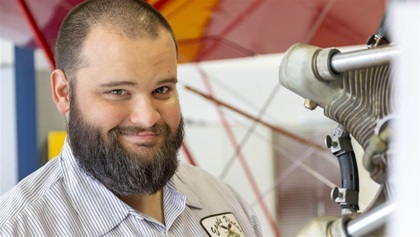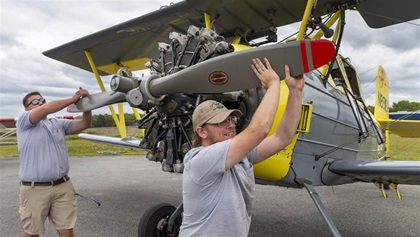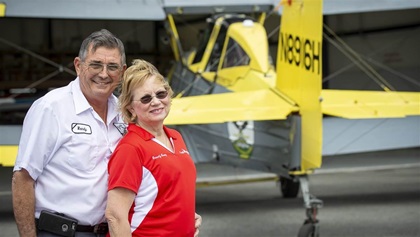Homegrown
Family ag flying school produces pilots for a hungry world
Eagle Vistas Ag School






Agricultural aviation is higher on the risk scale than other types of flying. There’s the low-level maneuvering that puts the pilot in proximity of trees and power lines. Twelve-hour days during the growing season can cause fatigue. Distractions like texting in the cockpit will kill an ag pilot quicker than a weekend pilot.
Randy and Beverly Berry have made it their mission to improve the training pipeline that creates agricultural pilots. Operating Eagle Vistas Ag School at Inverness Airport (INF) in Florida, the Berrys work one on one with new pilots; experienced pilots who want to become ag pilots; and commercial pilots looking for other career options.
Classic sprayers
Eagle Vistas’ training airplanes form a visual timeline in the hangar: a 1959 Cessna 305E L–19 Bird Dog; a 1960 Piper PA–25 Pawnee; and a 1976 Grumman Ag Cat, the hulk of the fleet with a 600-horsepower Pratt & Whitney R-1340 engine.
“Our L–19 is made of new stuff—it did not go to Vietnam or Korea,” said Beverly Berry. “We found it in Texas and it had 350 hours on it.” The Bird Dog has an astounding 60 degrees of flaps, which deploy like twin barn doors.
New ag pilots start with dual instruction in the Bird Dog—after the Berrys have assessed their tailwheel skills. Come in lacking basic stick-and-rudder skills and the Berrys will help you with that. Come in with zero flight time, you’ll first go next door to Right Rudder Aviation and earn a private pilot certificate in that flight school’s Piper PA–11 Cub Special before returning to Eagle Vistas to start your ag training.
If proficient in tailwheel flying, the student begins with 10 hours of dual instruction in the Bird Dog. “It is a good transition for the Cessna ag planes” because of the way it sits, and because it is known for humbling pilots, Beverly said. The 10 hours covers an introduction to low-level flying and acclimates pilots to the uncomfortable sensation of being so close to the ground—perhaps 8 to 10 feet.
“Your normal aspect as a pilot is, ‘No, I don’t want to do that,’” Beverly said. “There’s a process to get there.” Students will do S-turns, pattern work, and “safe” ag turns, as opposed to pulling hammerheads to save a few seconds on each row.
Next is swathing, which in ag flying context refers to the application of chemicals or fertilizer. A field at a nearby airport has been set up as a slalom course, laid out with 20 rows divided by flags—PVC pipes with garbage bags on top. Here, students can learn in a controlled environment, and they’ll learn how to do maneuvers the same way, every time. Then they’ll fly the course solo, while the instructor supervises the student from the ground and communicates by handheld radio.
At this stage pilots are flying without GPS. “We want their heads outside,” Beverly said. “We don’t want their heads down looking at a machine, we want them to keep safe. We’re training the peripheral. We bring in the GPS after that.” Ag pilots use GPS to help them not only locate precise positions that need to be treated, but to return to those spots if a second load is required. The equipment also can tell the pilot how many gallons per acre have been used, or how much is being dispersed at any time.
And, because the Berrys know that the cockpit makes a lousy classroom, ag students don’t learn to fly the GPS in an actual airplane. Instead, they drive a golf cart—outfitted with $20,000 worth of avionics—and become proficient with the GPS in that environment before stepping up to a GPS in the low-wing Piper Pawnee.
Precision flying
Remember Independence Day, the 1996 movie with Will Smith as the Marine pilot, and Randy Quaid as the drunken crop duster? The agricultural flying industry is still trying to live down that image—even though Quaid’s character went on to save the world by flying a ballistic weapon into the heart of the alien spaceship.
It’s why the Berrys focus on professionalism, why they created their own syllabus for their training, and why they stress doing things in a safe manner the same way every time. It’s why they have been working with the National Agricultural Aviation Association to create certification standards for training and to promote safe working conditions for ag pilots.
“When we hear people say ‘ag pilots are crazy,’ I say to them, ‘You must understand this is precision flying, just like aerobatics,’” said Beverly Berry. “Do you think aerobatic pilots make it up as they go? They practice and practice to do the things they do accurately. That’s exactly what our [industry] is: precision flying learning this particular skill.”
As trainee pilots move from the Bird Dog to the Pawnee, they learn how to fill the airplane’s hopper, and how the airplane’s center of gravity shifts once it drops its load. Finally, there’s more dual training in the beefy Ag Cat, which gives students an introduction to flying a more powerful aircraft, or a refresher if need be—not to mention extensive ground school in which pilots learn about FAR 137, chemicals and pesticides, personal protection, and more. “The pilot is responsible for whatever he puts out,” Randy Berry said. “He’d better know what’s in that airplane. He’d better know what the requirements are.”
Why not do all the training in the Ag Cat? That would hike costs, considering that the big Pratt & Whitney burns 28 gallons of fuel per hour. And, while turbine aircraft are heavily utilized in agricultural flying because they can carry larger loads and can cover territory faster—as much as 2,000 acres in a day—Randy Berry believes it’s folly to start a new ag pilot out in a turbine aircraft, even if that pilot has previous turbine experience flying commercially.
“It’s not the difficulty or complexity of the turbine engine,” he said. “Ag aviation is a completely different situation, because we are flying at a much lower speed. Don’t think that ag aircraft are jet airplanes flying very slow close to the ground. Think of them as tractors flying faster, high above the ground. It’s a whole different concept.”
Farmers in the ranks
Since launching Eagle Vistas in 2007, the Berrys have trained pilots who want to start their own business; those who want to work for a commercial spraying operation; and, more recently, farmers who want to fly their own aircraft to treat their acres.
“Even the midsize farms are buying little Pawnees so they can have early detection of whatever problem, and have a rapid response,” Randy Berry said. “In any business, the more you can contain and control yourself, the more productive you’re going to be.” Spraying also saves wear and tear on expensive farm equipment. If operating commercially under FAR 137, farmers can treat neighboring fields for compensation and offset their own costs.
Training costs range from $50,000 to $70,000 for a private certificate, instrument rating, and commercial pilot certificate with ag training. Randy Berry said pilots who learn in their own airplanes can reduce costs, and he is ready to help students acquire an appropriate airplane. He’ll also travel to a client’s farm to help set up a spraying operation once training is complete.
In between running a busy flight school and seeking to improve the ag flying business in general, the Berrys devote sweat equity toward bringing entry-level agricultural aircraft back to the market. Piper Aircraft is no longer making Pawnees; Grumman sold the type certificate for the Ag-Cat, and the company that now owns it is not manufacturing the aircraft. While Air Tractor and Thrush Aircraft produce high-performance, high-quality airplanes, their multi-million-dollar prices are out of reach of smaller operators.
“We’ve been active in trying to bring entry-level airplanes into the market,” Beverly Berry said. When Piper sold the PA–25 type certificate to Laviasa Aeroindustria, an Argentinian company that was building them under license, she and Randy were part of a team that imported one of those airplanes, now called the Puelche, to the United States. “It was the first airplane manufactured in Argentina and exported in 60 years,” she said. “Our ideal situation with that one is to put on a diesel turbocharged engine. That would get rid of the problem of avgas” in foreign countries where aviation fuel is more expensive and not as widely available, and for commercial operators that utilize turbine aircraft
The Berrys brought the Puelche to aviation shows and received a good reception. “We told the company we need support and parts,” she said. “You can’t bring in an airplane and not have parts. We’re still in touch with them and working with investors to bring it to the states.” With a new owner in place at Laviasa, Berry is hopeful that momentum will start up again.
Meanwhile, the Berrys are working with GippsAero in Australia which has a U.S. type certificate for an entry-level aircraft. “We think that would be a game changer,” she said.
Email [email protected]






